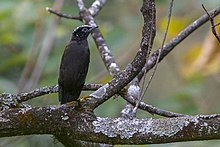Purple cochoa
| Purple cochoa | |
|---|---|

| |
| Male fromWest Sikkim | |
| Scientific classification | |
| Domain: | Eukaryota |
| Kingdom: | Animalia |
| Phylum: | Chordata |
| Class: | Aves |
| Order: | Passeriformes |
| Family: | Turdidae |
| Genus: | Cochoa |
| Species: | C. purpurea
|
| Binomial name | |
| Cochoa purpurea Hodgson,1836
| |
Thepurple cochoa(Cochoa purpurea) is a brightly coloured bird found in thetemperate forestsof Asia. It is a quiet and elusivebirdspeciesthat has been considered to be related to the thrushes offamilyTurdidaeor the relatedMuscicapidae(Old World flycatchers). They are found in dark forested areas and is found in the canopy, where it often sits motionless.
Description
[edit]This bird appears dark in the shade of the forest and the colours become clear only when it is lit by the sun. The crown is silvery blue and a black mask runs over the eye. A grey carpal patch is present at the base of the black wing feathers and a wing patch is prominent. The tail is silvery blue with a black terminal band. The male has dull purplish grey secondaries and coverts and the body is greyish while the female has rufous replacing the purple.[2][3][4]

The genus name is from the Nepali word for the bird and was used byBrian Houghton Hodgson.[5][6]The family position of the cochoas has been unclear with some sources suggesting that they belong to the Muscicapidae while others have suggested them to be in the family Turdidae. The latter suggestion has found more support in recent molecular studies.[7]
Distribution and habitat
[edit]It is found inBangladesh,Bhutan,China,India,Laos,Myanmar,Nepal,Thailand,andVietnam.In India, it is found along the Himalayas with the western limit about 100 km west of Musoorie.[8]
Its naturalhabitatsare subtropical or tropical moist lowlandforestsand subtropical or tropical moistmontane forests.[citation needed]
Behaviour and ecology
[edit]The species is not very active and is found mainly in the canopy. The breeding season is May to July, when it builds a cup shaped nest in a fork. The nest is covered with moss, lichens and a white thread-like fungus which is said to be distinctive. Three pale sea-green eggs with some blotchy markings are laid and both sexes take turns in incubation. The birds are shy at the nest and slip away even when disturbances are afar.[9]The song consists of is a low whistle while other calls include asitand softtrrrs.[2]Charles Inglis reported that the birds have an iora-like whistling call in the mornings and evenings.[10]These cochoas feed on berries, insects and molluscs.[9][11]While picking fruits from trees they were observed behaving likeflycatchersdoing short sallies.[12]
References
[edit]- ^BirdLife International (2016)."Cochoa purpurea".IUCN Red List of Threatened Species.2016:e.T22710144A94236723.doi:10.2305/IUCN.UK.2016-3.RLTS.T22710144A94236723.en.Retrieved13 November2021.
- ^abRasmussen PC & JC Anderton (2005).Birds of South Asia: The Ripley Guide. Volume 2.Smithsonian Institution and Lynx Edicions. p. 371.
- ^Oates, EW (1890).Fauna of British India. Birds. Volume 2.Taylor and Francis, London. pp. 159–160.
- ^Hussain,SA; Waltner,Robert C (1975)."Occurrence of the Purple CochoaCochoa purpureaHodgson, near Mussoorie, U.P. "J. Bombay Nat. Hist. Soc.72(2): 552.
- ^Jobling, James A. (1991).A Dictionary of Scientific Bird Names.Oxford University Press. p.57.ISBN0-19-854634-3.
- ^Hodgson, B.H. (1836)."Description of two new species belonging to a new form of the Meruline Group of Birds, with indication of their generic character".Journal of the Asiatic Society of Bengal:358–360.
- ^Sangster, G; Per Alström; Emma Forsmark & Urban Olsson (2010)."Multi-locus phylogenetic analysis of Old World chats and flycatchers reveals extensive paraphyly at family, subfamily and genus level (Aves: Muscicapidae)"(PDF).Molecular Phylogenetics and Evolution.57(1): 380–392.Bibcode:2010MolPE..57..380S.doi:10.1016/j.ympev.2010.07.008.PMID20656044.
- ^Jamdar, Nitin (1986)."Notes on Orange Parrotbill (Paradoxornis nipalensis), Blackfaced Flycatcher-Warbler (Abroscopus schisticeps) and Purple Cochoa (Cochoa purpurea) from Garhwal Himalayas ".J. Bombay Nat. Hist. Soc.83(2): 444–446.
- ^abAli, S. & S.D. Ripley (1998).Handbook of the birds of India and Pakistan. Volume 9(2nd ed.). Oxford University Press. pp. 17–19.
- ^Inglis, C.M (1935). "The Purple Thrush (Cochoa purpurea)".The Journal of the Darjeeling Natural History Society.10(1): 28.
- ^Baker, ECS (1924).Fauna of British India. Volume 2(2nd ed.). Taylor and Francis, London. pp. 184–185.
- ^Viswanathan, Ashwin; Naniwadekar, Rohit (1 February 2015)."Diet and foraging behaviour of Purple Cochoa Cochoa purpurea in Namdapha National Park, India".Forktail.30:145–147.

